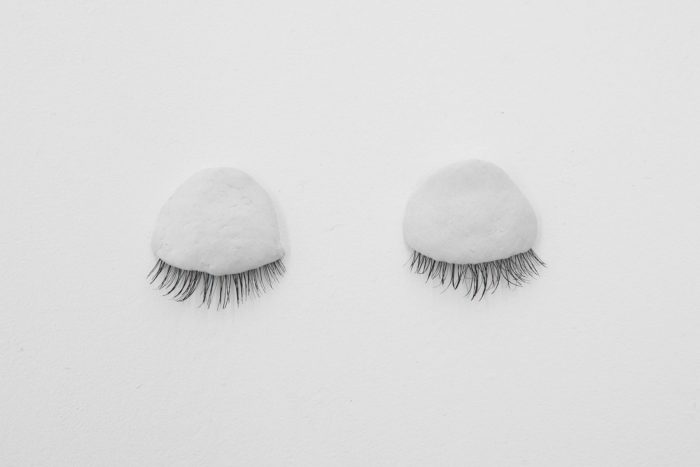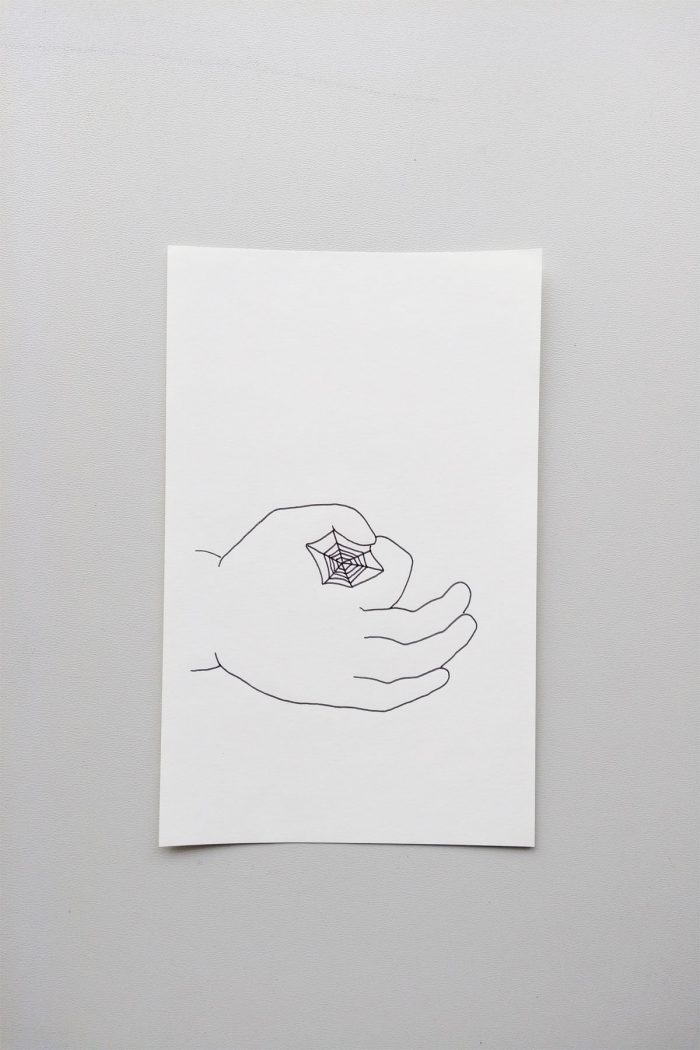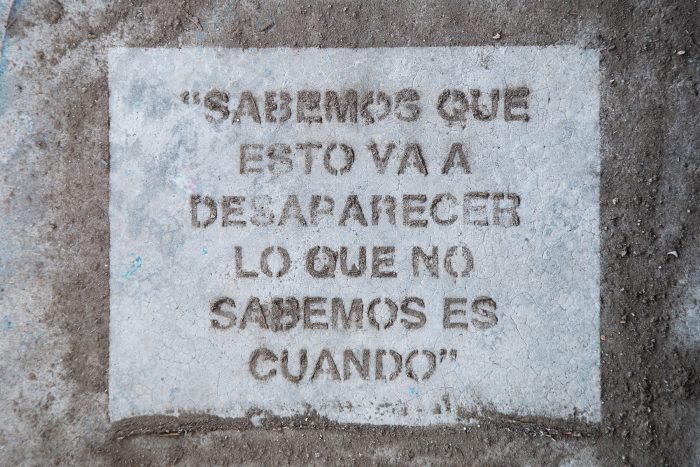Issue 16: Images Quiver in the Dark
Bruno Enciso Vargas, Alan Sierra, Diego del Valle Ríos
Reading time: 13 minutes

09.12.2019
Artist Alan Sierra, philosopher Bruno Enciso and Diego del Valle Ríos, editor of «Terremoto», weave a network of interrogations around the instability of images. Amidst the hypervisibility that constantly over-saturates us, they begin to question the possibility of a pause: The blink lies as a power condition to critically look that which we gaze at.

For the image to become an image, it must be
pierced by textuality, the image lives in silence.
—Bruno Enciso
Diego del Valle Ríos: While editing and doing research for this issue, I recalled Franco “Bifo” Berardi’s book The Soul at Work, in which he speaks about the cognitariat—that is, a working class that we produce through interfaces that present our eyes with images whose flow and rhythm—defined by our clicks and taps—sustain the capitalist machine.
I think then of the downcast eye as a constant referent that you evoke in your philosophizing on the image, Bruno. Is this overexploited worker on strike demanding the simple pleasure of the nap, or are they simply exhausted?
Whatever the reason, I think a possible banner for the cause of this downcast eye could be Palacio interior [Interior Palace], a pair of eyelids Alan sculpted that invites us to close our eyes to conjure the fantasies, dreams, and deliriums revealed when we contemplate the folds in the silence that lie in the dark of our eyelids. In other words, Alan asks us to learn to navigate in the absolute freedom of the unknown. Could it be that this toxic system subjects us to the vertiginous overproduction of images because it recognizes that rest is lifeforce? I am thinking, for example, of surrealist anti-imperialism, which becomes anti-colonialism when it reaches the Caribbean; or the works made by HIV-positive artists, in which the body is life and not a condemnation; or the flight of Black communities from the plantation.
When the alienating pulse of the images that haunt us and wear us down with fear or stress is interrupted, we find a space to imagine other worlds beyond the one that has failed us. I ask myself, how can the eye rest? Can images offer rest? What can an image do as an escape route from imposed passivity?
I always ask myself about the function of closing one’s eyes. What is the purpose? Can rest be a form of protest?
Alan Sierra: This makes me think of Aldous Huxley’s The Art of Seeing, which is very interesting because it is not about art or sight. Rather, it is a manual for improving your vision through exercises for the ocular muscle in order to stop using glasses. It is an attempt to strengthen the perceptive apparatus in order to no longer depend on an interface and therefore to see better. This same idea could be used as a metaphor and applied to technology or the ideological apparatuses we use to understand the world.
Bruno Enciso: I would like to set out two examples to establish my position; the first is that of the downcast eye: fatigue, exhaustion, or opacity; the second is the power of the imagination. The downcast eye cannot avoid asking itself about the power of the imagination. However, for me it is important to affirm the downcast eye—or elaborate it sufficiently enough—so as to not just return to it the antecedent of a productive muscular imagination. I think when the gaze is tired is an important and complex moment to speak of the subject and its present in contrast to the imagination as something powerful, which, once again, opens up an exteriority. An important aspect of the downcast eye is not just mentioning the palacio interior, but visiting it; seeing its rooms, wandering through its gardens. I feel comfortable affirming its dejection to show that the image is not complete and contains flaws.
For Martin Jay (author of Downcast Eyes: The Denigration of Vision in Twentieth Century French Thought), the eye, as a body in itself, functions as a gerund. It is always eyeing. In this sense, the downcast eye is not only about problems with the perceived image of the world, but also subjective problems.
AS: It is very difficult to think of a silent revolution. I always ask myself about the function of closing one’s eyes. What is the purpose? Can rest be a form of protest?
DDVR: I remember a phrase you wrote, Alan, in a letter to Griselda Benavides for her show in Interior 2.1[1]: “To imagine is a personal, intimate, and individual act.” Recognizing oneself as downcast means recognizing one’s vulnerability. It is about being intimate with ourselves. And given that being downcast is a constant, we are also always vulnerable. We are a gerund of sighs and lumps in the throat. A continuous eyeing in which the image of our fantasy is never achieved, but is based on its incompleteness.
That is why I am suspicious of the futurists’ position on film; they take for granted that the future is a finished image, when it is really just the opposite: imagining is permanent uncertainty.
BE: The example of futurist films is powerful. The period represented in cult films like Back to the Future or Bladerunner has arrived; that temporality is already ours and cars do not fly and humanity has not reached the limit sketched out in those theoretical-artistic dérives on the posthuman. What do these failed images tell us?
AS: Here, I need to establish a distinction between the practice of storytelling and the importance of negativity in theory. In his book Fragmentos de Frankfurt [Fragments of Frankfurt], Stefan Gandler sets out the problem with theory that speaks of the future: all theory that aspires to provide concrete possibilities of social change is prophesy. The only thing theory is capable of is analyzing reality and it can only tell us which errors should not be repeated. On the other hand, we have stories. What could be the function of stories?
A few days ago, I ran into the artist Manuela García at the show El castillo de los ladrillos rotos [The Castle of Broken Bricks].[2] When I opened the door, I saw her in the scenery of that ruined building, she was crouching to observe some roses and she was wearing a very pretty big hat. All I could ask her was: What is the role of the artist at the end of the world? Is it our job to tell stories? Are our actions palliative? Is this the care we can provide? What should a person dream of at the end of days?
DDVR: Now I’m thinking of seropositive artists during the HIV crisis in the nineties. I’m thinking about the work of José Leonilson, Feliciano Centurión, or Omar Shiliro, who called for moments of pause in which contemplation allowed poetic fantasies of healing to unfold. Specifically, I’m thinking of Centurión’s embroidered blankets and cushions, which called for the gaze—the imagination—to rest in the face of a society that constantly lashed out with pathologizing and condemnatory publicity campaigns. For them, closing their eyes was a way of reconnecting to a body rendered outdated by cognitive attacks.
As people who believe in images and art, we are in need of a sense of urgency to assume the strategic position that artistic thinking holds in the permanent state of war we live in, one from which we can provide moments of pause, of acceptance, of contemplation in the face of the enemy’s attacks, whether you call it capitalism, fascism, neoliberalism, etc.
It is important not to reduce the problem of the image to a question of evidence. Evidence completely covers images and promises to understand them completely, as if eyes could not look around.
BE: The enemy may not be outside but rather within us. Thinking about the downcast eye and the palacio interior also involves a certain agency connected to our fury, despondency, and where it is that we direct those feelings. No one ever says, “My eyes are part of the problem.” It seems interesting to think about abandoning the confrontational Hegelian schema that requires a resolution. That leaves us with a problem, but one that you can access and inhabit differently, rather than just identifying it as something that can be corrected. Blinking can offer relief but that does not mean that dejection is exhaustion, a wound, or even blindness.
AS: Do you remember that passage in Thus Spoke Zarathustra when Nietzsche writes about man’s convictions:
“’What is love? What is creation? What is longing? What is a star?’—so asketh the last man and blinketh.
[…]
‘Formerly all the world was insane,’—say the subtlest of them, and blink thereby.”
Blinking acts as a rhetorical device to discuss the inconsistency of a discourse as opposed to the always-open, always-watching eye.
I thought of a personal observation exercise through which I try to pay attention to the social reality that encircles what I imagine. In this country, the end of the world is happening every day: in forced disappearances, in black bags, in violent acts that remain mute. Is closing one’s eyes an option for those who face violence?

BE: It is important not to reduce the problem of the image to a question of evidence. Evidence completely covers images and promises to understand them completely, as if eyes could not look around.
Working on the image with downcast eyes implies a lot of exhaustion. The gerund of eyeing—of looking—implies that you are working all the time and that the image is viscous. The downcast eye does not rest, as you said, Diego. The image is never complete. The image is never clear, fixed, and stable, rather it is in crisis, falling, or vibrating. This means we use more energy to address images, this is what gives more weight to the idea of repose.
Paul Valéry once said that images would reach us like water from the tap. I think that the urgency you point to comes with recognizing that if the image surrounds us and floods us, we have to learn to swim.
DDVR: I inevitably think of the space in which we—participants in the system of contemporary art—find ourselves. We are drowning in a sea of imaginations. Each artist or curator presents an individual imagination that is always subsumed into the productive drive, which artistic and cultural labor in Mexico involves and in which the neoliberalization of the scene prevents the synchronized swimming we need to find our imaginations and think together about what we are doing and how we are doing it in the social context we share. Is being colorblind to violence a symptom of the downcast eye? And what happens if we all close our eyes at the same time in search of a political imagination from this shared obscurity?
AS: Perhaps it implies working with our hands and not our eyes. In art, there are many examples that respond to this dynamic. We have seen the work of writing reviews replaced by images of the installation. It is not necessary to go to any shows or write about them because images will reach you one way or another through apps, magazines, and email. I think that the fact that many artists are interested in writing is precisely a response to this synthesizing of discourse in the image.
BE: I think that eyes are like hands, because you are truly participating in something with them. The question of the image and labor prevents you from thinking that vision is passive in nature; perception is pierced by action.
When I see something, I put it in my hand; when I receive a notification about a show by an artist who interests me that is curated by a person who works on issues that interest me and I make time to visit said show, that is already something real. I think the question for the image implies thinking of it as an occurrence and recognizing that we are actively part of it.
AS: I just recalled Susan Sontag’s The Aesthetics of Silence, in which she discusses the assimilation of spiritual thinking and seems to defend individuality from imposed collectivity, returning to the interior world. Returning to the story and the need for narrative, I am now thinking about Jung’s text Flying Saucers: A Modern Myth of Things Seen in the Sky, in which he analyzes cases of encounters with extraterrestrials to ask himself about the social importance of the individual fact, of testimony. We need to be told about experiences that demonstrate that the magnificent can still be experienced in society.
DDVR: The magnificent, the surrealist, the multidimensional narrative image.
BE: To speak of the potency of images in surrealism is to point to the present crisis. Surrealism presupposes the watchful gaze that observes, like that of the tiger who jumps over the elephant. Insisting on affirming the downcast eye is to contemplate the possibility of not looking attentively.
AS: It seems that the image was a slightly lazy consequence of surrealism, which was originally a political and literary project. Surrealism was about creating a proposal that allowed people to dignify their inner worlds and to act in a way that would allow them to generate energy in any circumstance. I am interested in the translation of surrealism in Latin America, where, arriving late, it permitted the emergence of distinct political imaginations. What would a surrealism of the present look like?
BE: Tremendous question. There is a moment in which we can suspend the idea that our current situation of being surrounded by images is distressing, just for an instant, and think about how all that surrounds us has the power to open up a surrealism of the present, which could change what is in front of you—which allows you to realize that the image is more than a condemnation.
AS: I think that surrealism today would need to ignore the production of images and maybe focus on ethics.
A surrealist ethics that can escape from the regime of consumption we live in: Why buy when you can reimagine? Perhaps one could propose an ethics contoured by an ecology of images?
BE: Exactly, the downcast eye can transform the problem into a question. I think that powerful questions can only be seen with downcast eyes, where images are not so ubiquitous.
I am suspicious of ethics because I think that the question of the image revolves around rethinking the aesthetic-political binary to avoid thinking of politicizing the aesthetic or aestheticizing the political: they are one and same, they have always been together.
DDVR: Both tropes force us to ask new questions about what is narrated, who narrates, and how we narrate through critical, intersectional thought. What are the surrealist imaginations— those that assume uncertainty as a permanent condition of dreaming—that are making a call for ethics? How do these imaginations set out the aesthetic-political?
AS: Can a dream be political? Can a dream be critical? I don’t know. I confronted this question recently thinking about my writing. How can one write art criticism today without carrying the responsibilities implied in being part of a small scene, where if you write something compromising you may jeopardize your career? I thought of the dream formula: “I dreamt that this work melted,” “I dreamt that the show was closed because of a scandal.” In this way, responsibility becomes part of the dream; I am free to hide the intentions of my discourse in it.
But now I find myself needing to make a distinction between a dream and surrealism; the dream of the dispossessed is very different than surrealism of the dispossessed.
DDVR: Of course, the dream became instrumentalized by capitalism as an image of what one aspires to.
AS: Can an image commit a crime?
DDVR: Can a dream solve a crime?
AS: Can a dream be just?
BE: These questions already respond directly to this issue’s theme: What is the political power of an image? I would add a few more questions: Can an image be held responsible? Who does this affect?

Interior 2.1 is an independent exhibition space in Guadalajara, Jalisco, Mexico.
El castillo de los ladrillos rotos was a collective show organized by Guadalajara90210 in the context of Gallery Weekend Mexico 2019. More information:
Comments
There are no coments available.